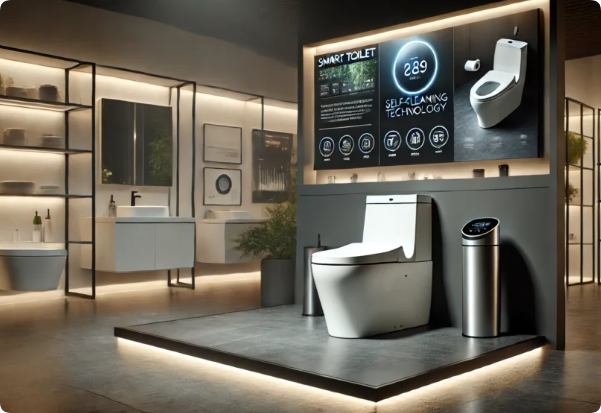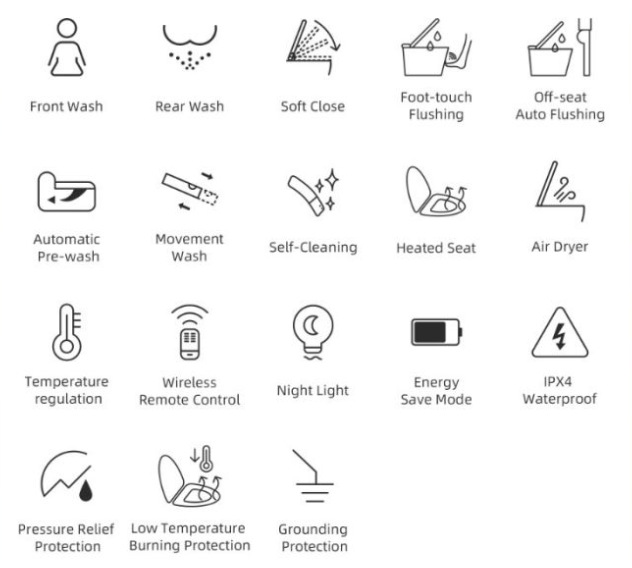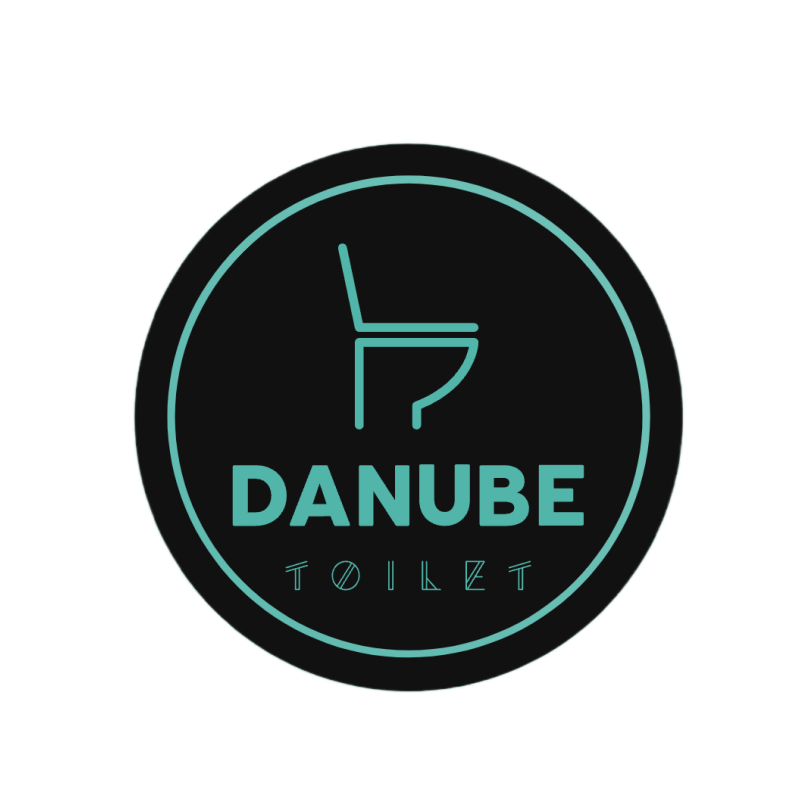Understanding the Mechanics and Considerations for Smart Toilet Users
In recent years, smart toilets have become an integral part of modern bathrooms, offering a range of high-tech features that promise to enhance comfort and hygiene. From heated seats and self-cleaning systems to built-in bidets and air dryers, smart toilets deliver convenience and luxury. However, one critical question arises for many potential buyers: Can you flush a smart toilet without power?
This question is particularly relevant for businesses in the B2B sector who need to assess the reliability and practicality of incorporating smart toilets into their offerings. In this blog, we will explore the functionality of smart toilets without power, comparing different models and providing valuable insights for B2B purchasers looking to make informed decisions.
What Is a Smart Toilet?

A smart toilet, also known as a high-tech toilet or a “smart bidet,” incorporates advanced technology designed to improve the bathroom experience. These toilets are equipped with features such as:
- Heated Seats: To provide comfort during colder months.
- Bidet Functionality: Including warm water sprays for cleaning, adjustable pressure, and even air drying.
- Automatic Flushing: Some models flush automatically when the user stands up or leaves the seat.
- Self-Cleaning Mechanisms: Using UV light or other technologies to keep the toilet clean.
- Deodorizing Systems: To maintain fresh air in the bathroom.
- Touchless Controls: For more hygienic operation.
While these features are undeniably convenient, they rely heavily on electricity to function. But, what happens if the power goes out? Let’s break it down.
Can You Flush a Smart Toilet Without Power?

In short, it depends on the model and the specific features of the smart toilet. Here are the key factors that affect whether or not a smart toilet can be flushed without power:
- Basic Flush Mechanism Most smart toilets, just like regular toilets, are equipped with a traditional flush mechanism that works independently of the electric features. This means that even if the power is out, you can still manually flush the toilet in the same way you would with a standard toilet. However, some high-tech functions, like automatic flushing, will not be available without power.
- Electric Flush Mechanism Some advanced smart toilets have electric-powered flush systems, which rely on motors or sensors to initiate the flush. If these features are active, a power outage would prevent the toilet from flushing automatically. However, the toilet may still be manually flushed using a mechanical handle or button if available.
- Bidet and Other Electronic Functions For smart toilets that feature bidet functionality, warm water sprays, heated seats, and air dryers, these features rely entirely on electricity. Without power, these functions will be unavailable, but you can still use the toilet as a traditional unit, provided the flush mechanism works manually.
Do You Need Electricity To Flush A Toilet? – Proficient Plumbing & Heating
Key Considerations for Smart Toilet Users Without Power
For B2B purchasers considering smart toilets for their clients, it’s important to understand that power outages may impact certain functionalities but won’t necessarily render the toilet completely unusable. Here’s a summary of what to expect without power:
| Feature | Functionality With Power | Functionality Without Power |
|---|---|---|
| Basic Flush | Fully operational | Fully operational (manual) |
| Automatic Flush | Works with sensors | Does not work without power |
| Heated Seat | Fully functional | Not functional |
| Bidet Functionality | Fully functional (warm water, adjustable pressure) | Not functional |
| Air Dryer | Fully functional | Not functional |
| Self-Cleaning System | Fully functional | Not functional |
| Deodorizing System | Fully functional | Not functional |
How to Ensure Your Smart Toilet Functions During Power Outages
While smart toilets offer many conveniences, it’s essential for businesses to recommend solutions that can mitigate the inconvenience of power loss. Here are some suggestions:
- Backup Power Options
Some smart toilets come with a built-in battery or have the option for a backup power supply. This allows the essential functions like flushing and heated seats to continue operating during short power outages. For longer power cuts, some units may include a manual flush option, which can be invaluable for users. - Hybrid Models
Another option is to choose hybrid smart toilets that offer both electric and manual options. For example, a hybrid flush mechanism that works both automatically (when powered) and manually (during a power outage) ensures that users are never left without the ability to flush. - Separate Power Sources for Critical Features
Some models have separate power systems for essential functions like the flush mechanism and non-essential features like the bidet or heated seat. These models are ideal for areas that experience frequent power outages. - Smart Toilet Design Considerations
When sourcing smart toilets for commercial spaces like hotels, restaurants, or office buildings, businesses should prioritize toilets that have accessible manual flush systems in case of power failures. It’s also beneficial to recommend models that are energy-efficient and feature long-lasting batteries.
Smart Toilets in Commercial Spaces: A Good Investment?
For B2B buyers, smart toilets are a growing trend in the hospitality and commercial sectors, but they come with a price tag that makes them a more significant investment than traditional toilets. Despite this, the added features can provide excellent value, particularly in luxury hotels, high-end restaurants, and modern office spaces.
However, businesses should weigh the pros and cons when recommending smart toilets to customers. Factors to consider include:
- Customer Expectations: Do the customers expect high-tech features that can’t be compromised by power outages? Are they willing to pay more for smart features?
- Power Supply Reliability: Is the location prone to power outages? If so, the recommendation should include hybrid models or those with backup power options.
- Cost vs. Benefit: Smart toilets typically cost more than traditional toilets. Businesses need to assess whether the added value of comfort, hygiene, and luxury justifies the investment.
Conclusion: Is It Worth the Investment?
In summary, the ability to flush a smart toilet without power largely depends on the type of toilet and its specific features. While the basic flush mechanism can typically function without electricity, advanced features such as automatic flushing, bidet functions, heated seats, and air dryers will not operate without power. To ensure reliable functionality during power outages, businesses can look for hybrid models or units with backup power options.
For businesses in the B2B sector, it is crucial to understand the potential limitations of smart toilets and consider both the advantages and drawbacks when making procurement decisions. Smart toilets are an investment in comfort, hygiene, and luxury, but it’s essential to balance these benefits with considerations like power reliability and cost.
By understanding the nuances of smart toilet functionality without power, businesses can make better decisions when selecting products for their clients, ensuring they meet both their functional and budgetary needs.
DANUBETOILET is a trusted ceramics manufacturer based in Chaozhou, China, specializing in providing B2B buyers with ODM customizations for large orders and OEM services for small-batch purchases. With a focus on quality and innovation, we offer a wide range of smart toilets and other sanitary ware products designed to meet the needs of global businesses.
